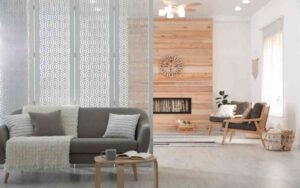LED lighting is one of the latest developments in the lighting industry. By reducing electricity costs and overall energy consumption, LED technology can change how organisations brighten their facilities through its energy efficiency and long lifespan.
What is LED lighting
Using an electric current through semiconductor material, an LED emits visible light through a process known as electroluminescence. LEDs are semiconductor devices that produce light. Due to this difference, LEDs are entirely unlike photovoltaic cells, which are used to convert visible light into electricity in solar arrays.
With LED technology, an astronaut landed on the moon, and portable AM radios were created. In addition, LED technology contributed to the development of solid-state transistors.
During the early 1960s, a young scientist at General Electric developed the first LEDs. Initially used as an indicator lights on circuit boards, they became well-known for their durability and energy efficiency. Many municipalities used the second generation of LEDs, which became available in the 1980s and 1990s, to replace traditional incandescent bulbs in streetlights. As a result, several people have begun to use them to replace fluorescent lights in outdoor signs.
Our current LED system uses the third generation of LEDs, which lasts longer, is stronger, performs better, and consumes less energy than any other lighting source. As a result, various LED applications are now available in industrial, commercial, and residential facilities.
A long lifespan
An LED light has a far longer lifespan than an incandescent bulb. For example, an average incandescent bulb lasts about a thousand hours, compared to a moderate LED light lasting 50,000 hours. An LED light can last up to 100,000 hours, depending on its use. An LED light can last between six and twelve years before it needs to be replaced, 40 times longer than an incandescent bulb.
LED lights last longer than fluorescent, metal halide, and sodium vapour.
Therefore, you save on replacement and maintenance costs for your company’s lighting.
Energy efficient
Lighting that uses LEDs has the advantage of being energy efficient as well. To measure the energy efficiency of a lighting source, you use useful lumens, which describe the amount of light it emits for every watt or unit of power it consumes. The lumens produced by light are measured in the past, but some are wasted. In comparison to other lighting solutions, LED lighting produces less waste light and more valuable lumens.
Your energy savings could be as much as 60% to 70% greater if you replaced all your lighting in your office, school, or other facility with LEDs. Depending on the type of lights being replaced and the type of LED lights being used, the improvement could be as significant as 90%.
A LED light bulb is a wise investment for the bottom line of any business as it is one of the most energy-efficient light sources available. When you replace a traditional light bulb with a LED light bulb, your energy consumption will plummet.
Environmentally-friendly
The importance of becoming eco-friendly is increasing for companies. A socially conscious consumer base is becoming increasingly interested in environmentally friendly options, which means companies can reduce their energy use while also attracting more customers through the use of an environmentally friendly light source.
There are also environmental benefits to LED lighting in their manufacturing process. For example, many traditional lighting sources use mercury internally in construction, such as fluorescent lighting and mercury vapour lights. As a result, when they reach the end of their lifespan, they require special handling. However, with LED lights, you don’t have to worry about these problems.
Low temperatures are not a problem
Fluorescent lamps, and other traditional lighting sources, require a higher voltage to start in cold weather, resulting in dimmer light.
It is, therefore, a better choice for lighting in freezers, meat lockers, cold storage spaces, and refrigerated display cases, as LED lights perform better in cold temperatures by about 5%. Furthermore, due to their efficiency in cold weather, these lights are also an ideal choice for parking lots, perimeter lights, and outdoor signs, as they are so efficient in cold weather.
Forget about heat and UV emissions
It is easy to see how hot an incandescent light bulb gets when it’s in use if you’ve tried replacing one right after it goes out. This is because traditional lighting systems, such as incandescent bulbs, use more than 90% of their energy to heat, whereas only 10% produces light.
A LED emits virtually no heat, and its light is mainly visible to the naked eye. As a result of this feature, medical experts are investigating LEDs as a possible solution to Seasonal Affective Disorder (SAD), which affects many people during the darker months of the year.
Additionally, LEDs are ideally suited for illuminating works of art that degrade over time when exposed to UV rays.
Flexible design
Since LEDs were initially used as indicator lights on circuit boards, they can be used almost anywhere despite their small size (about the size of a speck of pepper). When you combine them in bunches, they become conventional bulbs. In the same way as a string of Christmas lights, LED lights are stringed together to form a line or series of lights.
The possibilities are endless if you use LEDs for lighting in your facility. LEDs are so small that you can use them to illuminate everything from a shop floor to a football stadium.
Withstand frequent switching and instant lighting
If you need lights that can come on quickly, choose LED technology. Unlike metal halide lamps, LED lights can be turned on and off instantly, which requires a warm-up period. When you turn on a fluorescent light, it often flickers and takes two or three seconds to light fully. These are some of the complications you can avoid by installing LED lights. Moreover, traditional lighting sources have a shorter lifespan when switched on and off frequently.
LEDs are the perfect solution for your business when you need your lights to come back on right away after a blackout or power surge. Also, this feature allows you to turn on your lights when a building is opened early in the morning before the sun rises if you want them to be on promptly.
Unlike other components, LEDs do not dim when switched on and off, which makes them helpful in flashing light displays and applications that require sensors that frequently switch on and off.
Directionality
Light from conventional lighting technologies is distributed around the source 360°, which means accessories need to be purchased to deflect or channel the light into a particular direction if you want to illuminate a specific area.
Lighting areas that don’t need illumination will result in higher energy costs if you don’t use something to reflect or redirect the light.
LED lights only illuminate a 180° area, so they are ideal for use in industrial kitchens, hallways, and bathrooms. Additionally, the LED light will not degrade the artwork, and the lighting power will not be lost to the back of the light source, so it is ideal for lighting artwork.
Conclusion
There is little doubt that LED lighting is one of the fastest-evolving technologies. To no one’s surprise, its fast pace of innovation and continually sophisticated consumer needs contribute to its status as a life-changing technology. LED lighting technology will continue to be a popular option in 2023 and beyond as it becomes cheap enough to scale up and spread. If you ever decide to incorporate fully the idea of LED lighting into your home, do not hesitate to consult with your local electrician for advice. Going into the future is not an easy task.




